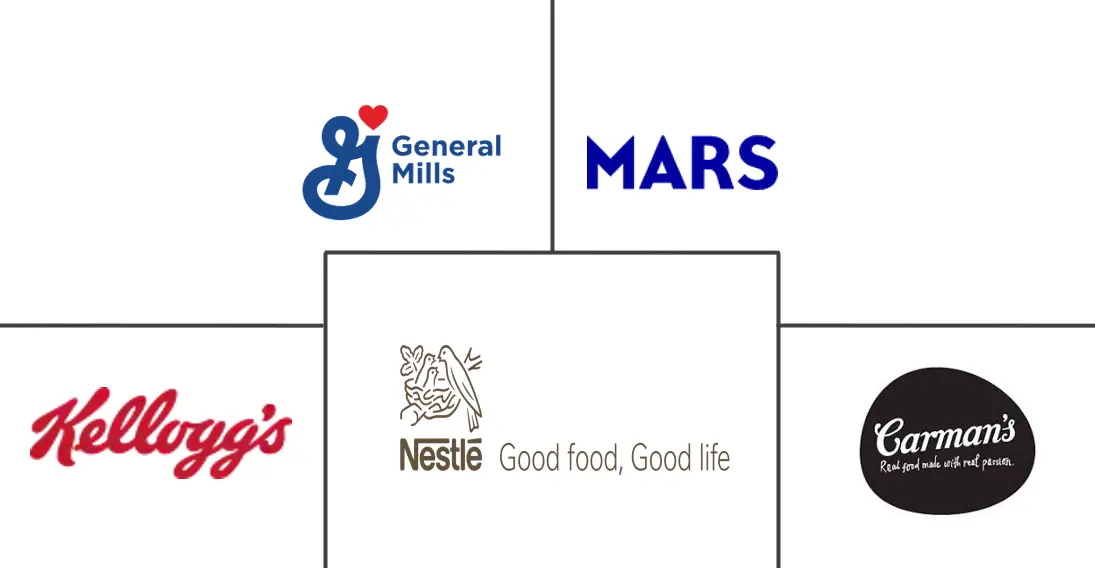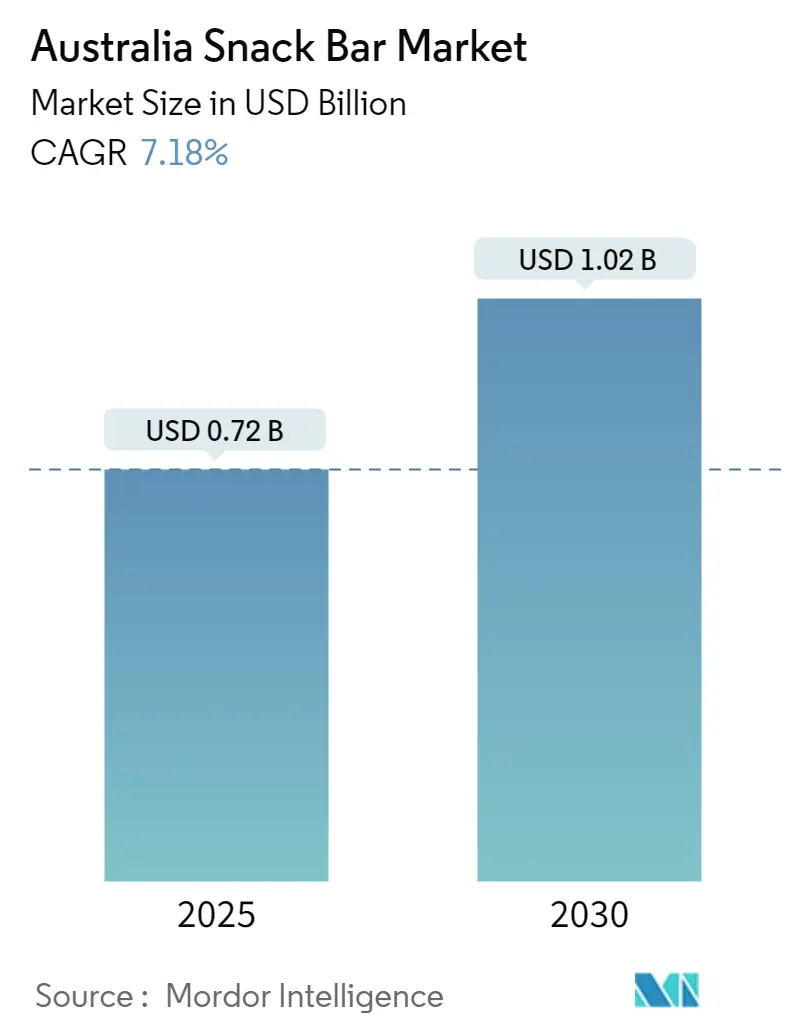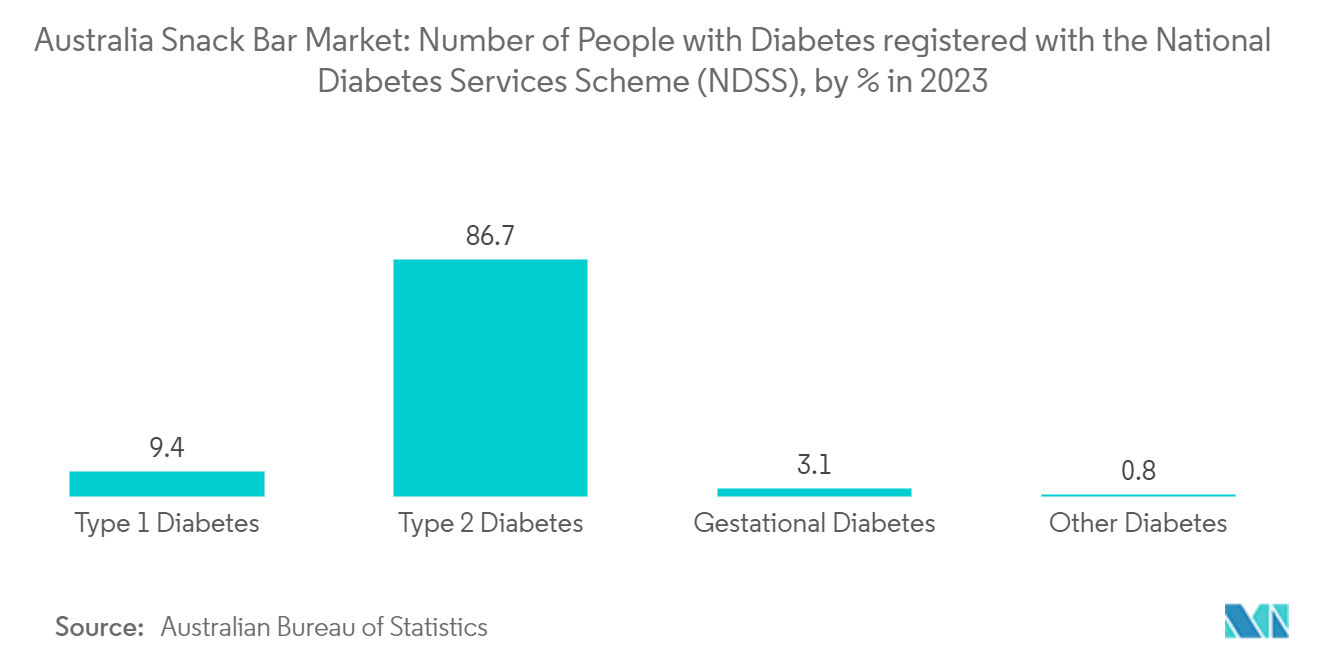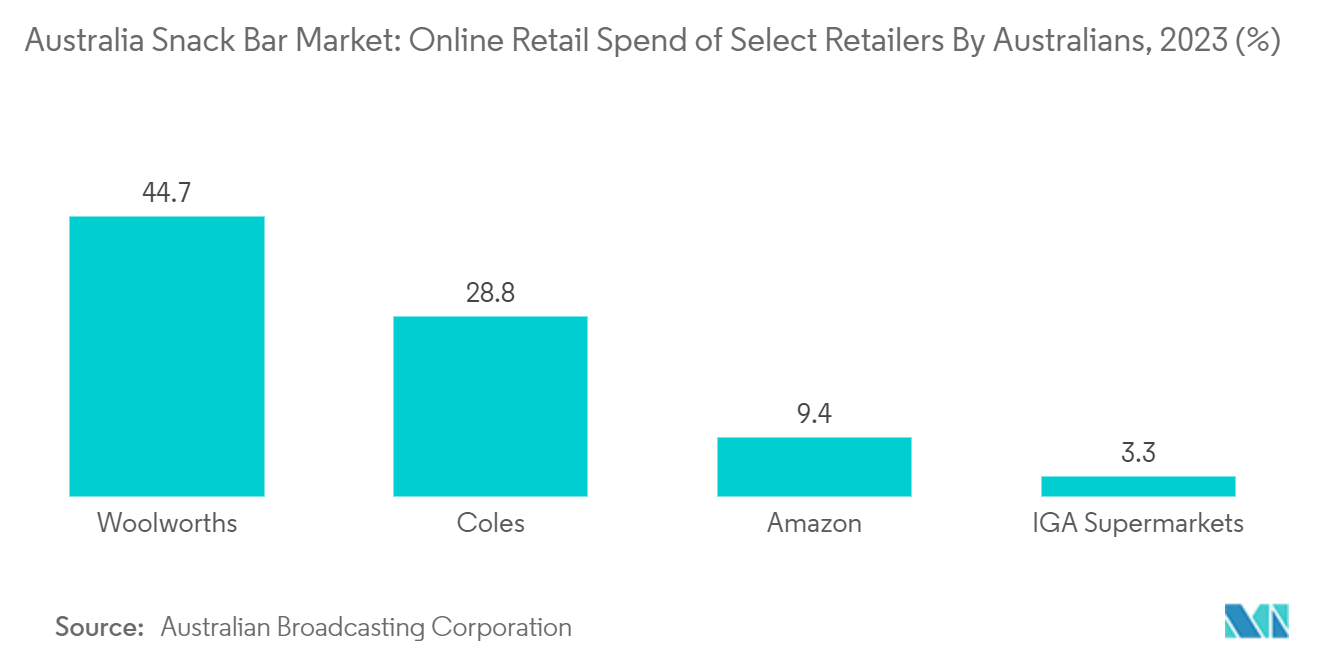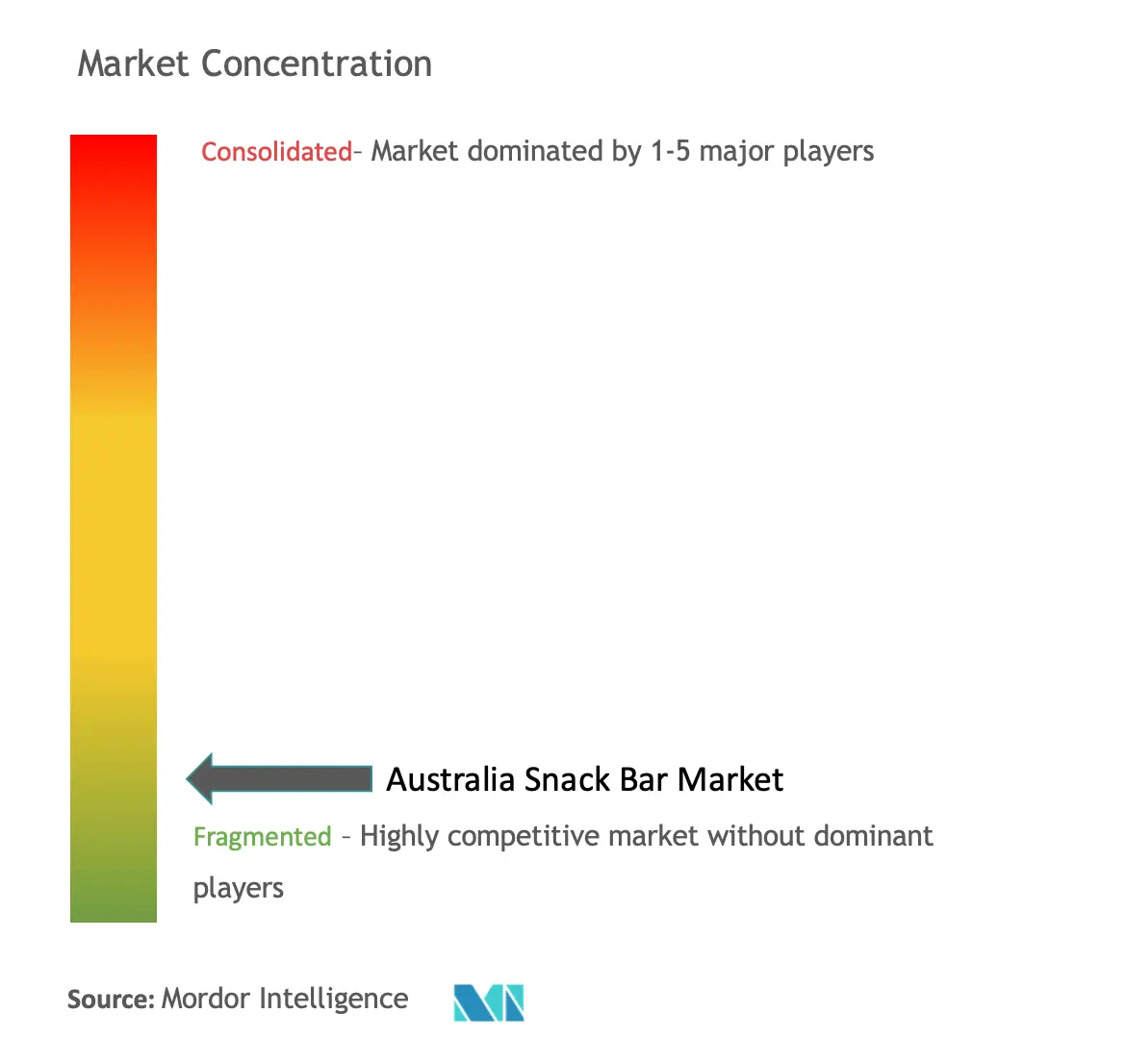Australia Snack Bar Market Analysis
The Australia Snack Bar Market size is estimated at USD 0.72 billion in 2025, and is expected to reach USD 1.02 billion by 2030, at a CAGR of 7.18% during the forecast period (2025-2030).
With increasingly hectic schedules, many Australians seek quick and convenient snack options that can be consumed on the go. Snack bars are portable, easy to eat, and can be stored without refrigeration, making them ideal for busy individuals. Snack bars come in various flavors, textures, and nutritional profiles, catering to diverse dietary preferences and lifestyles. Australian consumers spend more on healthy and convenient snack products due to the country's changing lifestyles, increasing dietary intake, and sports culture.
The trend of 'anytime' snacks is growing in the country, and health-conscious consumers use snack bars as meal replacements. Snack bars' most commonly perceived benefits are their high fiber content, antioxidant components, probiotics, vitamins and minerals, and high-quality protein content. This represents an exciting opportunity for the manufacturers of nutritious snack bars to step in and cater to the demand.
For instance, in 2024, Violet Crumble entered the wellness snacking market by partnering with supplement brand BSC to launch a chocolate protein bar range. These bars are available in two flavors, Chocolate Honeycomb and Caramel Honeycomb; each 55g bar has 16g of protein, less than 3g of sugar, and a 4.5 health-star rating.
Australia Snack Bar Market Trends
The Cereal Bars Segment is Expected to Account for a Major Share
The surging demand for fiber-rich snacks and the increasing awareness of the benefits of cereal bars are the key factors propelling the market's growth. Cereal bars have added nutritional advantages, such as whole grains, fiber, vitamins, and minerals. Consumers are looking for snacks that cater to their dietary choices and health requirements. Moreover, shifting lifestyles, westernization, the growing demand for value-added items like low-fat cereal bars, and the continuously increasing population are also crucial factors contributing significantly to this growth.
Additionally, there has been an increase in the number of people with diabetes in Australia. According to Diabetes Australia, there were approximately 1.5 million cases of diabetes in Australia during FY2023. Therefore, snack bar players have various opportunities within the reduced sugar, low-calorie, functional food ingredients, savory spins, and plant protein categories. Due to the availability of snack bars for a wide range of tastes, the demand for these products has significantly increased in Australia. For instance, in 2024, Australian brand Sunsol launched Sunsol Thins, a healthier range of cereal bars. The low-calorie bar provides a good source of fiber and is free from artificial flavors, colors, and preservatives.
The Online Retail Stores Segment is Growing at the Fastest Rate among the Distribution Channels
Online retail channels have become the fastest-growing retail sales channels for purchasing snack bars in Australia. These retail channels are known for offering snack bars under various labels, including clean-label products and free-form varieties. This enables consumers to easily select the products depending on their preferences, resulting in increasing demand for these retailers. The nationwide network of these operators allows easy access to local and mainstream snack bar brands. Some popular brands offering free-form varieties of snack bars through these channels include Carman's, think, Atkins, and Clif.
Online retail channels are running their business by adopting a range of marketing ideologies. These channels are focused on integrated technologies to offer customers complete convenience while purchasing various products, including snack bars. For instance, the concept of drone delivery has been around for many years in Australia. In 2022, the Supermarket chain 'Coles' became the first major Australian retailer to offer drone delivery directly from their stores to customers’ homes. The service provides customers with easy delivery options and offers various grocery items, including snack bars.
Australia Snack Bar Industry Overview
Competition is fierce in the Australian snack bar market. Several international and regional companies, such as Nestle SA, Mondelēz International Inc., Vitaco Health Australia Pty Ltd, and Carman's Fine Foods Pty Ltd, are expanding their reach and range, making it challenging for leading players to maintain a market share. Leading companies are introducing new products to maintain their market positions and meet the increasing consumer demand for snack bars with high-fiber content. Major players are concentrating on expanding their production capacity to serve a larger customer base.
Australia Snack Bar Market Leaders
-
Nestlé S.A.
-
Mars, Incorporated
-
General, Mills Inc.
-
Carman's Fine Foods Pty Ltd
-
The Kellogg Company
- *Disclaimer: Major Players sorted in no particular order
Australia Snack Bar Market News
May 2023: Nestle’s chocolate-flavored malt powder brand Milo launched two products with added protein to help support muscle building and repair. Milo Protein Snack Bars are fortified with 20% protein and a source of fiber.
April 2023: Mars Wrigley Australia announced a significant step forward in its sustainability journey by committing to transition all Australian-made chocolate and snack bars to new paper-based packaging that can be recycled via traditional kerbside recycling. Mars Wrigley's new paper-based packaging is available on 47g and 64g Mars Bars, 44g and 64g Snickers, and Milky Way 45g at all leading supermarkets and convenience stores nationally.
March 2023: Under its brand LCM, Kellogg's launched a Neapolitan-flavored snack bar. These snack bars are fortified with 25% less sugar and contain no artificial colors, flavors, or preservatives.
Australia Snack Bar Industry Segmentation
Snack bars are ready-to-eat baked products made with various ingredients such as granola, oats, chocolate, dried fruits, nuts, coconut oil, honey, and peanut butter.
The Australian snack bar market is segmented by product type and distribution channel. Based on product type, the market is segmented as cereal bars, energy bars, and other snack bars. Cereal bars are further sub-segmented into granola/muesli bars and other cereal bars. Based on distribution channels, the market is segmented into supermarkets/hypermarkets, convenience stores, specialist retailers, online retail stores, and other distribution channels. The market sizing and forecasts were made for each segment based on value (USD).
| Product Type | Cereal Bars | Granola/Muesli Bars |
| Other Cereal Bars | ||
| Energy Bars | ||
| Other Snack Bars | ||
| Distribution Channel | Hypermarkets/Supermarkets | |
| Convenience Stores | ||
| Specalist Retailers | ||
| Online Retail Stores | ||
| Other Distribution Channels |
Australia Snack Bar Market Research FAQs
How big is the Australia Snack Bar Market?
The Australia Snack Bar Market size is expected to reach USD 0.72 billion in 2025 and grow at a CAGR of 7.18% to reach USD 1.02 billion by 2030.
What is the current Australia Snack Bar Market size?
In 2025, the Australia Snack Bar Market size is expected to reach USD 0.72 billion.
Who are the key players in Australia Snack Bar Market?
Nestlé S.A., Mars, Incorporated, General, Mills Inc., Carman's Fine Foods Pty Ltd and The Kellogg Company are the major companies operating in the Australia Snack Bar Market.
What years does this Australia Snack Bar Market cover, and what was the market size in 2024?
In 2024, the Australia Snack Bar Market size was estimated at USD 0.67 billion. The report covers the Australia Snack Bar Market historical market size for years: 2019, 2020, 2021, 2022, 2023 and 2024. The report also forecasts the Australia Snack Bar Market size for years: 2025, 2026, 2027, 2028, 2029 and 2030.
Our Best Selling Reports
Snack Bar in Australia Industry Report
Statistics for the 2025 Australia Snack Bar market share, size and revenue growth rate, created by Mordor Intelligence™ Industry Reports. Australia Snack Bar analysis includes a market forecast outlook for 2025 to 2030 and historical overview. Get a sample of this industry analysis as a free report PDF download.

